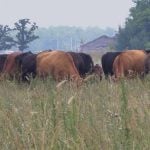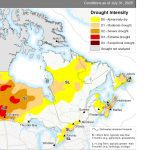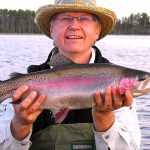A new insect pest is feeding on young pea and alfalfa seedlings in southern Alberta.
Robert Phillips, owner of Phillips Fertilizer in Lomond, Alta., said farmers and agronomists first noticed damage from pea leaf weevils in fields near Lomond around mid-May.
“Most of our peas are in the two to three node stage. The weevils are going after the younger ones – they’re more susceptible. As they get older, they’re not as susceptible to damage,” Phillips said.
“We’d never heard of them before. This is something entirely new to this area. I think they were here before, but because peas have become such a large part of everyone’s rotation, it’s just a breeding ground for them. With all the pea acres we have this year, we have a problem.”
Read Also

VIDEO: Green Lightning and Nytro Ag win sustainability innovation award
Nytro Ag Corp and Green Lightning recieved an innovation award at Ag in Motion 2025 for the Green Lightning Nitrogen Machine, which converts atmospheric nitrogen into a plant-usable form.
Phillips said no insecticide is registered for weevil control, but farmers in his area have sprayed anyway.
“They’re talking about a half to 1.5 bugs per plant, if you do a sq. metre count. If you’re in that range, it’s probably worth spraying.”
Dan Kusalik, a certified crop adviser with United Farmers of Alberta in southwestern Alberta, said he’s seen the weevil eating sweet clover plants on the outskirts of Lethbridge, along with widespread pea infestations.
He said he’s heard that farmers are considering a tank mix of insecticide and herbicide, rather than just straight herbicide, on fields where weevil populations are high enough to require control.
Scott Meers, pest risk management specialist with Alberta Agriculture in Brooks, Alta., said there won’t be an emergency use registration application made for insecticide control of the weevil this spring.
“The spraying will be done now and there’s no sense spraying past the six or seven node stage,” he said.
“Some of our peas are already pushing that stage now, so by the time we got it done, it wouldn’t be of any value.”
Meers said insecticides are registered in peas, but not for this insect. As a result, Alberta Agriculture can’t recommend using them for pea leaf weevil.
However, Meers acknowledged that pea growers may still want to control the weevil and advised sticking to an insecticide registered in peas.
He said insecticides that aren’t registered in peas come with minimum residue level issues and preharvest interval concerns that could seriously affect marketing.
“Selecting a product that’s not registered in the crop could have far more serious consequences than losing a few bushels of peas to the weevil.”
In the Saskatchewan 2006 Guide to Crop Protection, insecticides registered for peas include Matador, Malathion, Lannate and Lagon for sap feeders such as leafhoppers, pea aphid and spider mites. Defoliators, such as the alfalfa looper, can be controlled in peas with Sevin or Lannate.
Meers said the pea leaf weevil overwinters as an adult, typically in alfalfa fields but in other perennial legumes as well.
“Once the temperature gets above 12.5 to 15 C, they’ll fly out of their overwintering habitats and into pea fields,” he said. “They’ve been very mobile because we’ve had record setting temperatures in southern Alberta. They come into the fields and start feeding on the young pea plants.”
Adults make crescent-shaped notches in the leaves and can cause severe defoliation, stunting of the seedlings and meristem damage. The crop will stop growing until it is able to sprout out the side.
“The feeding looks like someone punched out the edge of the leaf with a hole punch,” Meers said. “It’s capable of setting the crop back, but it’s generally accepted that the major economic losses are not from the adult feeding. They’re from the larvae feeding on the root nodules. The worm stage feeds exclusively on the nodules of the pea plant. That can cause yield losses, quality losses, protein losses and may have an impact on nitrogen fixation for future crops.”
The larvae pupate in late July, emerge as second generation adults in August, feed and then find an alfalfa field in which to overwinter. Meers said the weevils tend to be a little worse in areas where there’s alfalfa, but that’s not a key factor.
“North of Foremost, (Alta.,) where I saw them real bad, there was not a lot of alfalfa around.”
He said the adults are about the size of a lygus bug, although a little skinnier, and brownish grey, similar to the colour of soil in southern Alberta.
“They’re very difficult to see on the soil and they have this annoying habit of playing dead when disturbed. So they fall down on the soil and look like a dirt lump,” he said. “It’s difficult to count adults because of the soil colour, so we’re using a damage threshold. If one out of three plants or more have feeding on the terminal leaflets – the most recently emerged node – or the clam leaves, then we suggest control would likely be economic.
“We’re also seeing them cause significant damage in seedling alfalfa. No idea on thresholds there, but we know a seedling alfalfa plant is very fragile, so feeding damage could have severe consequences. The leaves are so small on seedling alfalfa, they just eat them.”
He said spraying on established alfalfa wouldn’t be economical.
“They’re not feeding on the nodules, they’re just feeding on the leaves. A little bit of leaf feeding in alfalfa is not a big deal.”
Meers said the weevils are limited to southern Alberta and he’s now checking all counties south of the Trans-Canada Highway.
He expects work will be undertaken to acquire registration for next year.
“We may go emergency use or we may try to get full registration,” he said. “We’re not going to get caught twice.”
















